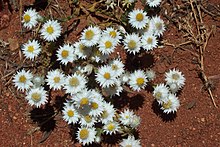마틴 돌팔이
Martin Quack마틴 돌팔이 | |
|---|---|
 마틴 퀵 (2014) | |
| 태어난 | 1948년 7월 22일 |
| 국적. | 독일. |
| 교육 | 다름슈타트 공과대학교, 그르노블 대학교, 괴팅겐 대학교, 에콜 폴리테크니크 페데랄 드 로잔느(Dr. sces technology) |
| 과학 경력 | |
| 필드 | 물리화학, 분자물리학, 분광학, 동력학 |
| 기관 | |
마르틴 콰크(Martin Quak, 1948년 7월 22일 다름슈타트 [1][2]~ )는 독일의 물리 화학자이자 분광학자이다.
생활과 일
마틴 퀵은 1966년 다름슈타트 공과대학에서 화학 공부를 시작했고 1969년부터 1970년까지 그르노블대학에서 독일 학술교류국(DAAD)의 펠로우로 계속 근무했으며 1971년 [1]괴팅겐대학에서 화학자 학위를 취득했다.1972년 그는 에콜 폴리테크니크 페데랄 드 로잔으로 옮겨 1975년 위르겐 트로와 함께 단분자와 복잡한 쌍분자 [3]반응의 통계이론에 대해 연구하며 박사학위를 취득했다.1973년 그는 웁살라에서 Per-Olov Löwdin에 의해 조직된 양자 화학 여름 학교에 다녔다.1976년부터 1977년까지 그는 UC 버클리 대학에서 윌리엄 H. 밀러와 함께 맥스 케이드 펠로우로 머물렀다.그 후, 그는 괴팅겐으로 이사했고 1978년에 그곳에서 하빌리테이션을 마쳤다.그는 1982년 본 대학의 정교수로 임명되었습니다.1983년부터 ETH 취리히에서 물리화학 교수로 재직하고 있으며 1986/1987년, 1991/1992년 및 2006/2007년에는 물리화학연구소장을 역임했습니다.
2005년에 그는 버클리 캘리포니아 대학의 밀러 초빙 연구 교수였습니다.2011년과 2012년에는 독일 분젠 물리화학회 회장(1. Vorsitzender)을 역임했습니다.
그의 연구 그룹(고해상도 적외선 분광 법, 다 광자 들뜸과 time-resolved 분광 법을 고용하여)모두 이론적으로 실험적으로,[4]면 터널링과 패리티 위반의 역학에 역점을 두고[5][6][7][8][9][10](그 electroweak기 때문에 분자의 양자 역학과 동역학을 조사한다.증인석의 teractionkiral 분자의 ard 모델).[11][12][13][14]가장 두드러지게 그들의 이론적인 일보다 일찍 계산(로[12][13][15]에서 검토)에서 원칙적으로 키랄 분자의 pr에 의해 enantiomers의 땅 국가들 사이에 차이로 검색될 수 있는이 예상 패리티 위반의 효과 크기의 주문이 더 큰 사이에 보여 준다.두더지의 ecision 실험고립된 [13][14][15][16]분자에서 패리티의 시간 진화의 근본적으로 새로운 운동 과정을 사용하여)그는 "고해상도 분광학 핸드북"의 편집자(프레데릭 메르크트와 함께)이다.[17]
상과 명예
- 1982년 분센 물리화학회 네른스트-하버-보덴슈타인상
- 1984년 FU 베를린 클룽(윌헬미 베버뱅크)상
- 1987년 버크 왕립화학회 강사
- 1988년 힌설우드 강사와 크리스텐슨 펠로우, 옥스퍼드
- 1991년 오토 바이어상
- 2002년 스위스 화학회 파라셀수스상
- 2006년 인스부르크 에르빈 슈뢰딩거 금메달
- 2009년 괴팅겐 대학교 명예박사
- 2012년 8월 빌헬름 폰 호프만 메달(독일화학회, GDCh)
- 2012년 CMOA QSCP 메달(Centre de Mécanique Ondulatoire Appliée, 파리)
그는 미국 물리학회 펠로우(1990년), 과학 아카데미 레오폴디나(1998년), 베를린-브란덴부르크 과학 아카데미(1999년), 미국 예술 과학 아카데미(2017년) 및 괴팅겐 과학 아카데미(2014년)의 특파원으로 선출되었다.2002년부터 2011년까지 스위스 국립과학재단의 국가연구위원회 멤버였습니다.2014년 그는 독일 과학 아카데미 회장 레오폴디나로 [2]선출되었습니다.
「 」를 참조해 주세요.
레퍼런스
- ^ a b Richard R. Ernst; Tucker Carrington; Georg Seyfang; Frédéric Merkt (2013). "Editorial: Special issue of Molecular Physics dedicated to Martin Quack on the occasion of his 65th birthday". Molecular Physics. 111 (14–15): 1939–1963. Bibcode:2013MolPh.111.1939.. doi:10.1080/00268976.2013.816092. S2CID 220377047.
- ^ a b "Curriculum Vitae (Academy of Sciences Leopoldina)" (PDF).
- ^ Martin Quack, Jürgen Troe (1981). "Current aspects of unimolecular reactions". Internat. Reviews in Physical Chemistry. 1 (2): 97–147. Bibcode:1981IRPC....1...97Q. doi:10.1080/01442358109353318.
- ^ Martin Quack (1977). "Detailed symmetry selection rules for reactive collisions". Molecular Physics. 34 (2): 477–504. Bibcode:1977MolPh..34..477Q. doi:10.1080/00268977700101861.
- ^ Martin Quack (1978). "Theory of unimolecular reactions induced by monochromatic infrared radiation". J. Chem. Phys. 69 (3): 1282–1307. Bibcode:1978JChPh..69.1282Q. doi:10.1063/1.436667.
- ^ Martin Quack (1989). "Infrared laser chemistry and the dynamics of molecular multiphoton excitation". Infrared Physics. 29 (2): 441–466. Bibcode:1989InfPh..29..441Q. doi:10.1016/0020-0891(89)90087-0.
- ^ Martin Quack (1990). "Spectra and dynamics of coupled vibrations in polyatomic molecules". Annual Review of Physical Chemistry. 41: 839–874. Bibcode:1990ARPC...41..839Q. doi:10.1146/annurev.pc.41.100190.004203.
- ^ Martin Quack (1993). "Molecular quantum dynamics from high resolution spectroscopy and laser chemistry". J. Mol. Struct. 292 (1–3): 171–195. Bibcode:1993JMoSt.292..171Q. doi:10.1016/0022-2860(93)80099-H.
- ^ Martin Quack (1995). "Infrared laser chemistry". Infrared Phys. Technol. 36 (1): 365–380. Bibcode:1995InPhT..36..365Q. doi:10.1016/1350-4495(94)00102-Q.
- ^ Martin Quack (1995). "Molecular infrared spectra and molecular motion". J. Mol. Struct. 347: 245–266. Bibcode:1995JMoSt.347..245Q. doi:10.1016/0022-2860(95)08549-B.
- ^ Martin Quack (1989). "Structure and dynamics of chiral molecules". Angewandte Chemie International Edition in English. 28 (5): 571–586. doi:10.1002/anie.198905711.
- ^ a b Martin Quack (2002). "How important is parity violation for molecular and biomolecular chirality?". Angewandte Chemie International Edition. 41 (24): 4618–4630. doi:10.1002/anie.200290005. PMID 12481315.
- ^ a b c Martin Quack; Jürgen Stohner; Martin Willeke (2008). "High-resolution spectroscopic studies and theory of parity violation in chiral molecules". Annu. Rev. Phys. Chem. 59: 741–769. Bibcode:2008ARPC...59..741Q. doi:10.1146/annurev.physchem.58.032806.104511. PMID 18173376.
- ^ a b Peter Dietiker; Edouard Miloglyadov; Martin Quack; Andreas Schneider; Georg Seyfang (2015). "Infrared laser induced population transfer and parity selection in 14NH3: A proof of principle experiment towards detecting parity violation in chiral molecules". J. Chem. Phys. 143 (24): 244305. Bibcode:2015JChPh.143x4305D. doi:10.1063/1.4936912. PMID 26723669.
- ^ a b Quack, Martin; Merkt, Frederic (2011). Handbook of High-resolution Spectroscopy. doi:10.1002/9780470749593. ISBN 9780470066539.
- ^ Sieghard Albert; Irina Bolotova; Ziqiu Chen; Csaba Fábri; L'ubos Horný; Martin Quack; Georg Seyfang; Daniel Zindel (2016). "High resolution GHz and THz (FTIR) spectroscopy and theory of parity violation and tunneling for 1,2-dithiine (C4H4S2) as a candidate for measuring the parity violating energy difference between enantiomers of chiral molecules". Phys. Chem. Chem. Phys. 18 (31): 21976–21993. Bibcode:2016PCCP...1821976A. doi:10.1039/C6CP01493C. PMID 27439591.
- ^ Martin Quack, Frédéric Merkt, ed. (2011). Handbook of High Resolution Spectroscopy. doi:10.1002/9780470749593. ISBN 9780470066539.


